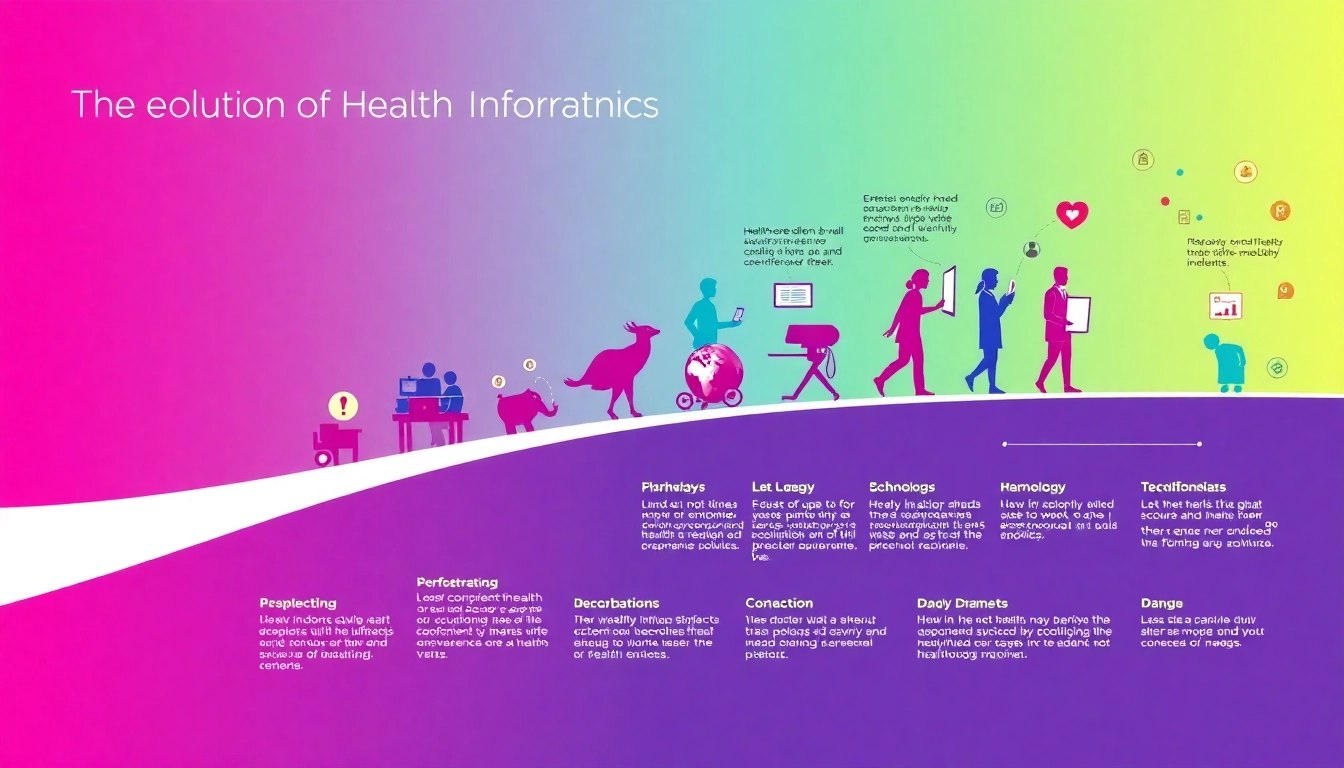
Introduction to Health Informatics
In today’s digital age, the role of health informatics has become increasingly vital in improving patient care and optimizing healthcare delivery systems. Health informatics blends information technology, data analytics, and healthcare to enhance patient outcomes and support clinical decision-making. Through the use of sophisticated tools and methodologies, professionals in this field are capable of transforming raw data into actionable insights, which ultimately lead to better healthcare practices. As healthcare continues to evolve, understanding the intricacies of informatics is essential for stakeholders at every level. For more insights and resources on this topic, visit www.informaticsview.com.
The Importance of Informatics in Healthcare
Health informatics plays a crucial role in enhancing healthcare services by improving data management, facilitating better communication, and streamlining workflows. It incorporates various skills and knowledge from data science, information technology, and healthcare, making it a vital interdisciplinary field.
One of the primary benefits of informatics is its ability to enhance patient safety. By leveraging electronic health records (EHRs), healthcare providers can reduce medication errors, track patient progress, and access comprehensive patient histories. Furthermore, clinical decision support systems (CDSS) provide healthcare professionals with crucial information at the point of care, promoting evidence-based practice.
Historical Context of Health Informatics
The roots of health informatics can be traced back to the 1960s, when early computer applications in healthcare began to emerge. Initially, these systems were primarily used for administrative tasks; however, as technology advanced, so did the applications of informatics in clinical settings.
By the 1980s and 1990s, the advent of personal computers and the internet revolutionized the field, enabling the development of more sophisticated health information systems. During this time, the need for a standardized approach to data management led to the establishment of various organizations and initiatives aimed at improving interoperability among health information systems.
Future Trends in Informatics
As we look to the future, several key trends are poised to reshape the health informatics landscape. The integration of artificial intelligence (AI) in healthcare represents one of the most significant advancements. AI algorithms can analyze vast amounts of health data to identify patterns, predict outcomes, and recommend treatment options tailored to individual patients.
Moreover, the increasing emphasis on telehealth services has accelerated the adoption of digital health solutions, making it essential for healthcare providers to integrate informatics into their practice. The use of mobile health applications and wearable devices is expected to enhance patient engagement, enabling continuous monitoring and real-time communication between patients and providers.
Key Components of Health Informatics
Data Management and Analysis
Data management is a foundational component of health informatics. Effective management of health data ensures accurate, timely, and secure access to information that healthcare providers need to deliver care. This involves the collection, storage, and maintenance of data within EHRs and other health information systems.
Additionally, data analysis allows organizations to derive meaningful insights from the information collected. By employing techniques such as predictive analytics, healthcare providers can forecast patient needs, identify at-risk populations, and improve resource allocation.
Technological Innovations in Healthcare
Technological innovation in healthcare is advancing at an unprecedented pace. From telemedicine platforms that facilitate remote patient consultations to big data analytics that enable population health management, technology is transforming the way care is delivered.
For instance, the implementation of cloud computing in healthcare not only enhances data accessibility but also ensures data security and compliance with regulatory standards. Similarly, blockchain technology is emerging as a robust solution for managing health records, offering enhanced security and transparency in patient data sharing.
Interdisciplinary Collaboration
Health informatics thrives on collaboration among various disciplines, including IT, healthcare management, clinical practice, and data science. This interdisciplinary approach fosters innovation by combining the expertise of different professionals to find solutions for complex healthcare issues.
Healthcare organizations that promote a culture of collaboration are more likely to develop robust informatics systems that address their unique needs. By incorporating perspectives from diverse fields, these organizations can design user-friendly interfaces and ensure that technology addresses the practical realities faced by healthcare providers.
Challenges in Health Informatics
Data Security and Privacy Issues
One of the most significant challenges in health informatics is ensuring the security and privacy of patient data. With the increasing amount of sensitive information being stored electronically, healthcare organizations must implement stringent measures to protect against data breaches and cyberattacks.
Compliance with regulations such as the Health Insurance Portability and Accountability Act (HIPAA) is critical. Organizations must invest in security technologies, conduct regular audits, and train staff on best practices for data privacy to safeguard patient information effectively.
Integration of New Technologies
Integrating new technologies into existing healthcare systems can be a daunting task. Many organizations face difficulties in aligning their current processes with innovative solutions, leading to disruptions in service delivery.
A successful integration strategy involves careful planning, stakeholder engagement, and iterative testing. Health informatics professionals must work closely with IT teams and clinical staff to ensure that new technologies meet user requirements and enhance, rather than hinder, clinical workflows.
Resistance to Change within Organizations
Change is often met with resistance, particularly in established healthcare institutions. Employees may fear that their roles will be diminished or that they lack the necessary skills to adopt new systems. It is essential for leadership to address these concerns transparently and foster an environment that values continuous learning.
Providing comprehensive training and ongoing support is fundamental to alleviating fears associated with change. Involving staff in the decision-making process and recognizing their contributions can also enhance buy-in and promote a culture that embraces innovation.
Best Practices for Implementing Informatics Systems
Effective Training and Support Structures
Successful implementation of informatics systems relies heavily on robust training and support structures. Healthcare organizations must develop tailored training programs that cater to the varying levels of technical proficiency among staff members.
Utilizing a combination of online modules, hands-on workshops, and one-on-one coaching sessions can better equip employees to navigate new systems. Additionally, establishing a dedicated support team can provide ongoing assistance and foster user confidence in utilizing informatics tools.
Evaluating System Performance Metrics
It is crucial to establish clear performance metrics to evaluate the success of informatics systems. Leveraging key performance indicators (KPIs) such as user adoption rates, system uptime, and data accuracy can provide valuable insights into system effectiveness.
Regularly reviewing these metrics allows organizations to identify areas for improvement and make necessary adjustments to enhance system functionality. Involving end-users in this evaluation process can also yield actionable feedback that informs future developments.
Enhancing User Experience
User experience (UX) is a critical factor in the successful adoption of informatics systems. A well-designed interface that is intuitive and user-friendly can significantly enhance efficiency and satisfaction among healthcare professionals.
Incorporating feedback from end-users during the design phase can identify potential challenges and ensure that the system meets their practical needs. Conducting usability testing allows organizations to refine interfaces and workflows, ultimately fostering a more positive experience for users.
Case Studies and Success Stories
Innovative Applications of Informatics
Several healthcare organizations have successfully leveraged informatics to improve patient outcomes and streamline operations. One notable example is the implementation of a telehealth initiative that allowed patients to consult with specialists remotely, thereby reducing wait times and enhancing access to care.
In another case, a large hospital system adopted a predictive analytics platform that utilized historical patient data to identify individuals at high risk for readmission. By targeting these patients with personalized care plans, the organization was able to significantly reduce readmission rates and associated costs.
Measuring Impact on Patient Care
The impact of health informatics on patient care can be measured through various metrics, including patient satisfaction, health outcomes, and operational efficiency. For instance, an organization that implemented EHRs reported increased patient engagement due to improved access to personal health information and reminders for preventive care appointments.
Furthermore, studies have demonstrated that the implementation of CDSS can lead to more accurate diagnoses and treatment recommendations, enhancing overall patient safety and outcomes.
Lessons Learned from Successful Implementations
Organizations that have achieved success in informatics often highlight the importance of stakeholder engagement throughout the implementation process. Involving frontline staff in decision-making fosters a sense of ownership and enhances the likelihood of user acceptance.
Moreover, building robust partnerships with technology vendors can streamline integration processes and lead to more effective system implementations. Continuous evaluation and feedback mechanisms are also essential for ensuring that informatics solutions evolve in alignment with clinical needs and technological advancements.





